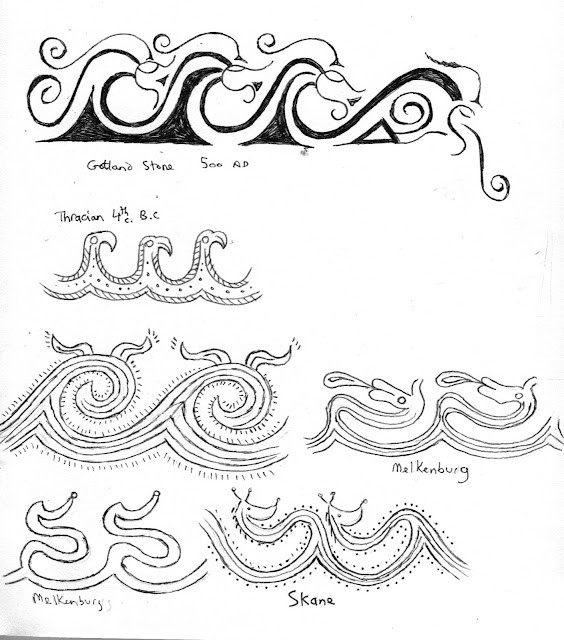Frae bank to bank the water pouring;
And the bonnie lass did quake for fear,
She heard the water-kelpie roaring."*
A page from my Sketchbook showing waves depicted as sea horses.
White horses racing across the ocean, white manes flaring. Tolkien used the image in the Lord of The Rings, when the river sweeps away the Dark Riders at the Ford of Bruinen. The imagery has been used in art, myths and poems for thousands of years. It is more than mere allegorical musing, as images from Greece testify. The sea horse, or hippocampus, was a chimera that had the head of a horse and body of a scaled fish, it is seen accompanying Triton, a sea god, as well as sea monsters such as Scylla.
I have long been intrigued by this design and references to Sea horses and Kelpies in old tales. Much Scottish folklore was documented by various folklorists back in the 1800’s, such as J.F Campbell. He travelled around the country writing down oral traditions and stories, which bear testament to an oral tradition sadly lost. Old tales that were themselves are like beads of sea glass found on a beach, their worn surfaces clouded. These fragments once belonged to a clearer, fully formed piece. This is how I regard much folklore. Tales were added and amended through the generations, sometimes in line with the religious and political needs of the community, thus adding, or subtracting elements to each tale. However, key elements persist and they are vital to the telling. Some even appear to reference pre-Christian deities. This is what I believe the folklore of the Kelpie myth refers to.
Many lochs and pools, rivers and streams had their Kelpie, or water horse. They were also known as Each Uisge, Voughans/Vaicghs and in the Shetlands as the less threatening appellation of Nuggles - these were said to look like Shetland ponies… so no threat there! The Kelpie/Kelpy were equated also with the Norse Nikr (Nix/Nixie and where Ole Nick comes from).
Some of the designs that the Picts left us that date from the 6-7th c. AD. Do these images relate to the Kelpie? Are there any references to these images in earlier Celtic art? Well yes, here are a few I’ve found over the years of collecting designs to carve.
A page from my Sketchbook, including the 'elephant'
design mentioned below.
 |
| This is one of my carvings - Please check the link below :> |
The so-called ‘Pictish elephant’ I believe is a representation of an early form of Kelpie. It appears to be much more benign, or passive. The positioning suggests this motif was powerful, and it often hovers above scenes of hunts, wars, kings and queens. And yes, perhaps the symbol came to represent a certain leader or tribe or clan, the same way Capricorn was adopted by the Legio II Augusta. Yet in the myths of Kelpies and sea horses, creatures that inhabit lochs and rivers, there suggests a belief in this image as a deity/spirit of associated with bodies of water. Christianity frowned upon such beliefs, so we have the all too familiar process of ‘demonisation,’ in which the original ‘genus locii,’ or spirit, becomes an evil thing that will only bring bad luck, a creature that would drag people into the depths, lurking in boggy lochs and fast flowing rivers, or ready to pounce on the unwary in the muddy banks.
In many tales and legends the Kelpie was a creature to be feared and sometimes it appeared as a magnificent horse, saddled and bridled, but whoever tried to ride the beast would find themselves stuck fast to its flanks, crying in terror as the beast dove into the dark cold waters of the loch.
However there are glimmers of an older, less malign version of the Kelpie, for example there was once a tale told that the materials for the building of St Vigeans, Forfarshire were brought there by a Kelpie. And beneath the church, which rested on foundations of iron bars, was a deep lake.
Another sketchbook page, this one depicting aquatic creatures, some a bit less friendly, others, the paired examples, possess an air of tranquility and affection about them.
Along with the tales of Kelpies there are also those of water bulls, mermaids off the coast, and the selkie. All these are associated with watery places. We know that pools and lochs were often revered by the Celts. In fact the beliefs of our ancestors, across the globe, infer that everything had its spirit or essence. The Romans named local spirits Genus Loci. In Scotland many of the major rivers were named after local spirits and worshipped, or honoured in some form or another.
Could it be that in these images we are seeing the lingering refrains of a spirit form, something that the peoples refused to relinquish, even in the early days of Christianity? Perhaps this in itself reveals why the Kelpie became so often a thing of malevolence. As Christianity became less tolerant of other beliefs, the church denounced the old ways the peasantry clung to. By changing their nature, warping the old deities, spirits and Genus loci wretched demonic beings best feared.
* From a Southern County Ballad (Quoted in Folklore of Scottish Lochs and Springs - James A. Mackinlay
Reference
Folklore of Scottish Lochs and Springs - James A. Mackinlay
Popular Tales of the Western Highlands - J.F Campbell
Reference
Folklore of Scottish Lochs and Springs - James A. Mackinlay
Popular Tales of the Western Highlands - J.F Campbell






No comments:
Post a Comment